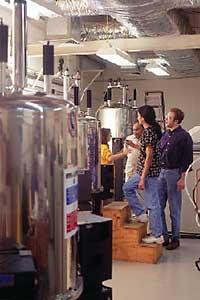SQUID: EMN in low magnetic field

In MRI, radiofrequency spectroscopy is performed within a magnetic field, and greater magnetic field, greater spectrum. The use of this property allows to know the composition of the mixtures, since the MRI does not "denounce" a specific nucleus: by influencing its magnetic field the neighbors of that nucleus, it is also possible to predict the presence of nuclear groups.
University of California chemist Alexander Pines and Lawrence Berkeley National Laboratory physicist John Clarke have tried to identify compounds in low magnetic fields. For this purpose, the sample of water, phosphoric acid and trimethyl phosphate has been studied in the ultrasensive SQUID detector to the magnetic field and the phosphore-oxide-hydrogen group has been separated in the spectral line.
The success of this trial is of great importance, since when MRI analysis is currently performed, the most expensive is to induce these high magnetic fields. MRI has applications in general analysis systems in organic chemistry and medicine, such as the development of three-dimensional models for the diagnosis of Alzheimer's, but also for many others.
Buletina
Bidali zure helbide elektronikoa eta jaso asteroko buletina zure sarrera-ontzian











